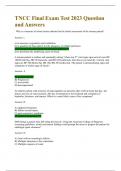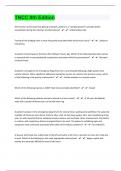Popular courses 'TNCC' at TNCC
TNCC Study guides, Class notes & Summaries
Looking for the best study guides, study notes and summaries about TNCC? On this page you'll find 4411 study documents about TNCC.
All 4.411 results
Sort by
 Popular
Popular
-
TNCC Final Exam Test 2023 Question and Answers – Open Book
- Exam (elaborations) • 13 pages • 2023
-
- $16.49
- 10x sold
- + learn more
TNCC Final Exam Test 2023 Question and Answers – Open Book Why is a measure of serum lactate obtained in the initial assessment of the trauma patient? A trauma patient is restless and repeatedly asking "where am I?" vital signs upon arrival were BP 100/60 mm Hg, HR 96 beats/min, and RR 24 breaths/min. Her skin is cool and dry. Current vital signs are BP 104/84mm Hg, HR 108, RR 28 breaths/min. The patient is demonstrating signs and symptoms of which stage of shock? An elderly patient wi...
 Popular
Popular
-
TNCC 8th Edition 50 Questions and Answers
- Exam (elaborations) • 7 pages • 2023 Popular
-
- $7.99
- 5x sold
- + learn more
The trauma nurse knows that placing a bariatric patient in a "ramped position" provides better visualization during the insertion of which device? - endotracheal tube Tearing of the bridging veins is most frequently associated with which brain injury? - subdural hematoma A patient is found lying on the floor after falling 13 hours ago. Which of the following laboratory values is expected with a musculoskeletal complication associated with this presentation? - Elevated creatine kinase...
TNCC Final Exam Test 2023

-
TNCC UPDATED Exam Questions and CORRECT Answers
- Exam (elaborations) • 29 pages • 2024
-
- $9.49
- + learn more
What is kinetic energy (KE)? - KE equals 1/2 the mass (M) multiplied by the velocity squared. What is the Mnemonic for the Initial Assessment? - A = Airway with simultaneous cervical spine protection B = Breathing C = Circulation D = Disability (neurologic status) E = Expose/Environmental controls (remove clothing and keep the patient warm) What is the Mnemonic for the Secondary Assessment? - F = Full set of VS/Focused adjuncts (includes cardiac monitor, urinary catheter, and gastric...

-
TNCC PASSED Exam Questions and CORRECT Answers
- Exam (elaborations) • 13 pages • 2024
-
- $8.49
- + learn more
1. Preparation and Triage 2. Primary Survery (ABCDE) with resuscitation adjuncts (F,G) 3. Reevaluation (consideration of transfer) 4. Secondary Survey (HI) with reevaluation adjuncts 5. Reevaluation and post resuscitation care 6. Definitive care of transfer to an appropriate trauma nurse - Initial Assessment 1. A- airway and Alertness with simultaneous cervical spinal stabilization 2. B- breathing and Ventilation 3. circulation and control of hemorrhage 4. D - disability (neurologic st...

-
TNCC Certification Exam Questions and CORRECT Answers
- Exam (elaborations) • 6 pages • 2024
-
- $7.99
- + learn more
Which of the following mnemonics can help a nurse prioritize care for a trauma patient with massive uncontrolled hemorrhage? - MARCH You are caring for a patient who was involved in a motor vehicle crash and is 32 weeks pregnant. Findings of your secondary survey include abdominal pain on palpitation, fundal height at the costal margin, and some dark bloody show. Varying accelerations and decelerations are noted on cardiotocography. These findings are most consistent with which of the...

-
TNCC Exam Guide Questions and CORRECT Answers
- Exam (elaborations) • 6 pages • 2024
-
- $7.99
- + learn more
What are the greatest risks for transport? - Loss of airway patency, displaced obstructive tubes lines or catheters, dislodge splinting devices, need to replace or reinforce dressings, deterioration in patient status change in vital signs or level of consciousness, injury to the patient and/or team members According to newtons law which of these two force is greater: size or force? - Neither. For each force there is an equal and opposite reaction. What is the relationship between mass ...

-
TNCC final exam test 2024 open book
- Exam (elaborations) • 18 pages • 2024
- Available in package deal
-
- $11.49
- + learn more
TNCC final exam test 2024 open book Why is a measure of serum lactate obtained in the initial assessment of the trauma patient? a) to measure oxygenation and ventilation b) to quantify the base deficit for the adequacy of cellular perfusion c) to gauge end-organ perfusion and tissue hypoxia d) to determine the underlying cause of shock - ANSWER c) *to gauge end-organ perfusion and tissue hypoxia

-
TNCC 8th Edition 50 Questions with verified Answers
- Exam (elaborations) • 8 pages • 2024
-
- $6.99
- + learn more
TNCC 8th Edition 50 Questions with verified Answers The trauma nurse knows that placing a bariatric patient in a "ramped position" provides better visualization during the insertion of which device? -ANS endotracheal tube Tearing of the bridging veins is most frequently associated with which brain injury? -ANS subdural hematoma A patient is found lying on the floor after falling 13 hours ago. Which of the following laboratory values is expected with a musculoskeletal complication asso...

-
TNCC Final Exam Test 2024 Question and Answers – Open Book | Graded A+
- Exam (elaborations) • 14 pages • 2024
-
- $10.29
- + learn more
TNCC Final Exam Test 2024 Question and Answers – Open Book | Graded A+ Why is a measure of serum lactate obtained in the initial assessment of the trauma patient? Answer: c - ️️ -a) to measure oxygenation and ventilation b) to quantify the base deficit for the adequacy of cellular perfusion c) *to gauge end-organ perfusion and tissue hypoxia ** d) to determine the underlying cause of shock A trauma patient is restless and repeatedly asking "where am I?" vital signs upon arrival ...

-
TNCC 8th Edition Questions and Answers(2024 edition) updated graded A+
- Exam (elaborations) • 5 pages • 2024
- Available in package deal
-
- $9.99
- + learn more
What are the greatest risks for transport? - answer Loss of airway patency, displaced obstructive tubes lines or catheters, dislodge splinting devices, need to replace or reinforce dressings, deterioration in patient status change in vital signs or level of consciousness, injury to the patient and/or team members According to newtons law which of these two force is greater: size or force? - answer Neither. For each force there is an equal and opposite reaction. What is the relation...

-
TNCC 8th Edition Assignment And Quality Answers 2024.
- Exam (elaborations) • 8 pages • 2024
-
- $8.19
- + learn more
MARCH mneumonic - Answer Massive Hemorrhage: Control with combat gauze, celox gauze, or chito gauze; replacement of blood loss with whole blood or 1:1:1 ratio of plasma, RBC, and platelets to achieve SBP of 80-90mmHg. Airway: Establish and maintain patent airway Respiration: Decompress suspected tension pneumothorax, seal open chest wounds, and support ventilation and oxygenation as required. Circulation: Provide vascular access (IV/IO) and administer fluids as required to treat shock He...




